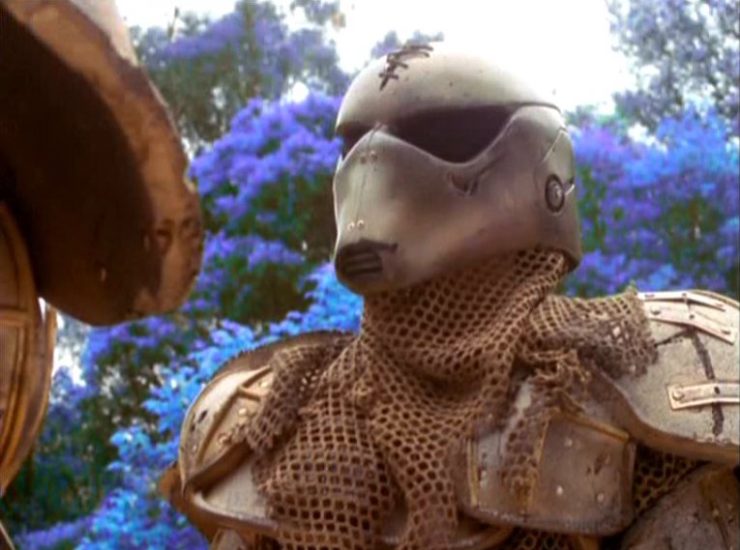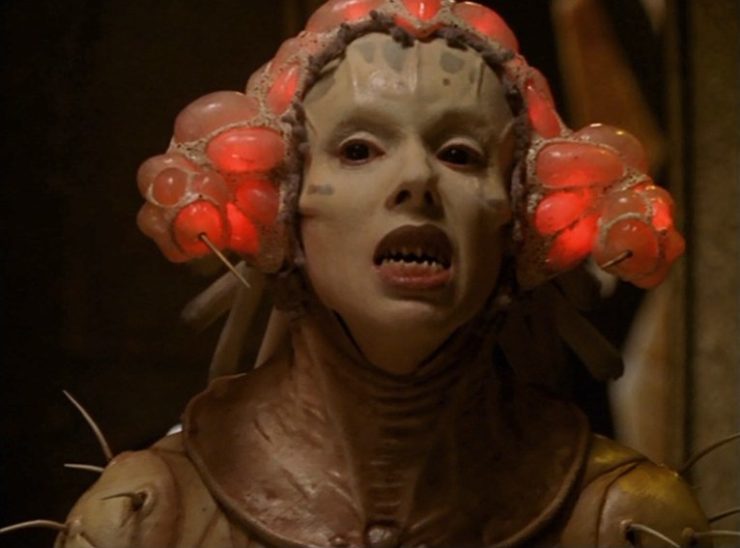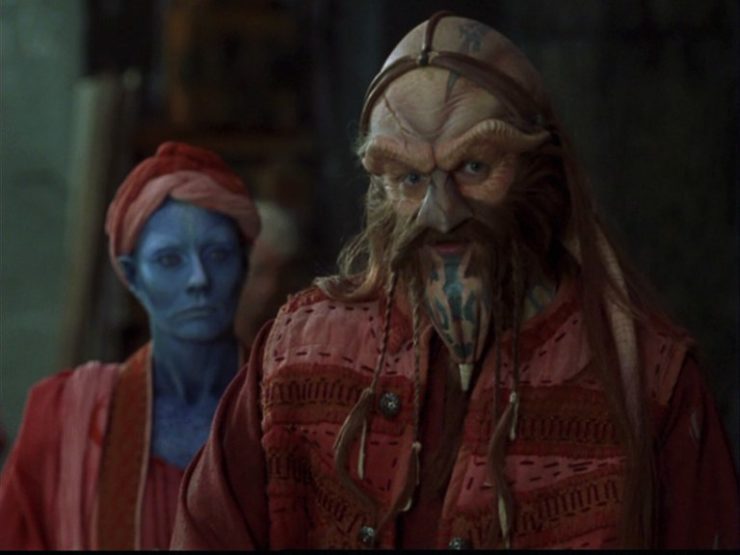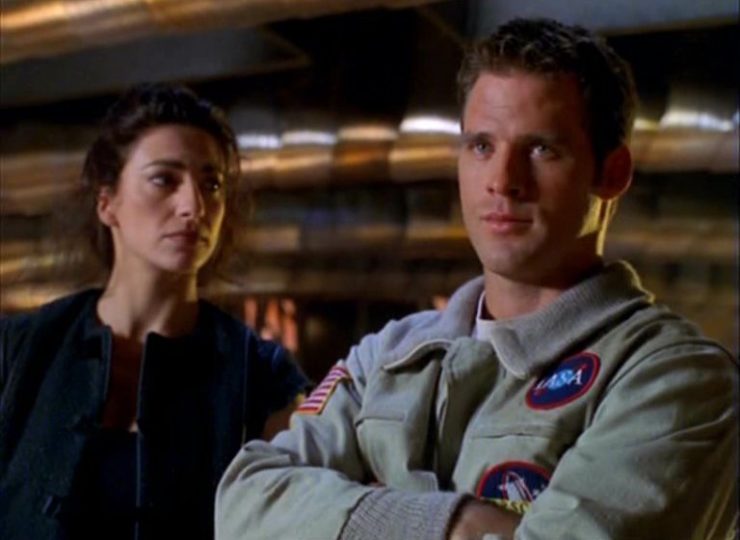I don’t remember exactly who told me to watch Farscape back in 2009, but I imagine the conversation went something like this:
THEM: “It’s this wild space opera and the best thing about it is that the main character has not only a beautiful slow-burn romance with an exiled space marine but also some really thorny nasty psychological stuff with his nemesis, who eventually ends up joining the team as a reluctant ally, along with pretty much every other main villain. I know you love that shit.”
ME: “oh no!!!!!!!!”
And then I watched the first season and spent the whole time twitching like a child who’s been told there will be ice-cream at the end of this journey, because where was everything I had been promised. It was a fun, offbeat interplanetary rampage, but most episodes were self-contained monster-of-the-week adventures, and the acting was sort of patchy at times, and where were the complex arcs I’d heard so much about?
And so I spent about ten years telling people that Farscape was a great series that really got going in season 2, and that you could skip most of the first season because it was silly.
This year I rewatched the show and realised I was wrong as hell and so is anyone else who might tell you this. Season 1 has a special joy.
(Obviously, this article contains some significant spoilers for the entire first season of Farscape.)
For the uninitiated, the premise of Farscape is that an all-American astronaut named John Crichton falls through a wormhole and ends up on the other side of the universe, where he throws in his lot with a group of escaped prisoners. They have stolen their prison ship and gone on the run from the authoritarian Peacekeepers—and in fact, the ship, Moya, is a living being in her own right, a “bio-mechanoid” who is also escaping captivity. This sustains the action for four seasons and a miniseries as the crew struggles to evade pursuit and find their way home through the “Uncharted Territories”. Season 1 deals with the early phases of the escape, as they bounce from planet to planet and learn to work together—more or less. It’s not until the end of the season that the series’ main antagonist is introduced and we get on our way to the emotional intensity and factional drama of the later seasons. And yes, if that’s what you want from the show, you could probably skip an episode or 15, but I think you’d be missing out.
Let’s start with the obvious: Season 1 has an incredible commitment to aesthetic. This is something which the show never loses, but in later seasons the action crystallises around several key factions and there isn’t as much scope for planet-hopping. Season 1 has maximum opportunity to showcase the sheer vibrant variety of the Uncharted Territories and it goes for it with abandon. From episode to episode we get space Western, ’50s pastiche, B-movie weird science and some pretty effective space horror, but there’s a unifying aesthetic that means it never feels too patchwork.
The colour palette is anarchic. Nobody seems to have felt that we need to be convinced of the gravity and importance of the show by making everything grey or “realistic”, so colour is used extravagantly to give us emotional access—for instance, the rich coppery palette of Moya’s interior conjures up a space that is both familiar and mysterious: it’s warm and inviting, but evokes the sense of a huge clockwork mechanism, non-human and difficult to understand. (Also, all of the bedsheets on board seem to be gold lamé, because that’s just how things are in space, I guess).
The character design is equally vibrant—multiple eyes, tendrils, mandibles, antennae. I think we’re all now agreed that physical effects have aged better than early CGI on the whole—but the puppets in Farscape always looked great. (If you can’t suspend your disbelief for puppets, I must sorrowfully say that this probably isn’t the show for you.) The approach is very much “we need to make this look like an alien planet—let’s spraypaint about 70% of the vegetation electric blue!”—and it works. This is a show about the ad-hoc, the off-beat, the unpolished, and the occasional dodgy-looking prop is exactly the seasoning it needs.

A lot of the conflicts in season 1 are, in essence, ecological. Our heroes live a marginal existence where space and resources are limited, but some care is taken not to suggest that they’re entitled to those resources over and above other forms of life. The crew’s relationship with Moya the living ship exemplifies this: she communicates with them only through her symbiotic Pilot, and they understand very little about her technology and motivations, but she has her own needs and desires which are respected even when they conflict with those of the crew. Most notably, in “They’ve Got A Secret”, we learn that Moya is pregnant, and the crew must deal with the fact that they’re no longer Moya’s first priority, or the only vulnerable life-forms on board. There’s never a sense that Moya’s life is worth less because she isn’t human or remotely human-like.
Over the whole span of the show, the “ship invaded by parasites” plot crops up a few times. Season 1’s offering, ‘Exodus from Genesis’, in which the ship becomes a host to a swarm of alien insects who damage the life support systems, is the best of the bunch. The crew manages to communicate with the new arrival and negotiate a compromise, allowing the swarm to remain for long enough to complete its reproductive cycle before leaving. Where later episodes on this theme (Season 2’s ‘Beware of Dog’ or season 3’s ‘Losing Time’) generally end in destroying the invader, here survival is framed as a balancing act in which overlapping interests must be reconciled, rather than an individual scramble to the top of the pile. John and Zhaan’s conversation near the end of the episode is the closest early Farscape gets to a thesis statement:
John: So, who lives and dies in your world is as arbitrary as it is in mine?
Zhaan: The answer is reverence for all living beings, which comes with time and patience.
At least in this first season, it’s very rare that “shoot the baddies to win” is the solution to anyone’s problem—the show isn’t preachy or self-satisfied about it, it just doesn’t seem to be interested in telling the kind of story where our heroes are automatic moral victors or where violence is glorified. For instance, the episode ‘Throne For A Loss’ brings the crew into conflict with a band of mercenaries who use a drug to magnify their strength and aggression. There’s also a B-plot in which the priestess Zhaan takes pains to counsel a captured mercenary through withdrawal. This makes for a very odd tonal mishmash, but even here, in one of the more violent early episodes, the solution is ultimately born from compassion, when Zhaan’s prisoner confirms to his leader that he’s been well-treated and the crew are sent on their way.
However, the writing isn’t naïve about the fact that respect for all life is often easier said than done. Consider the episode ‘Bone to be Wild’. The crew are stranded in a forest which has only two inhabitants: one delicately beautiful and helpless alien woman, one monstrous and aggressive plant-man. Of course, appearances are deceiving. She’s a cunning predator who eats bones, he’s a nature-loving scientist. But things aren’t even that simple—she’s a thinking, feeling person, who’s starving to death after an ecological collapse which has been deliberately orchestrated by the scientist’s people for research purposes. She’s survived by killing and eating her friends and family. Farscape sometimes gets dark. It’s also thoughtful about evil: the way callous systems compromise everyone they touch, the way people can end up perpetuating the horrors they’ve experienced. It’s genuinely interested in moral grey tones. The character writing is at its most compassionate when exploring the psychological fallout for those who’ve been caught in the machinery of the tyrannical Peacekeeper regime—but we’re never delivered a simple answer.

This never entirely goes away in later seasons—one of my favourite elements of the series is the way the antagonists are gradually brought on-side as fully-realised individuals, without writing out their original motives—but as more time is devoted to arc plot, the show has fewer chances to construct these moral puzzle-boxes. Further, as John develops from a peaceable scientist into a more hardened and pragmatic fugitive, the series as a whole seems to become more willing to use violence as a tool for resolution.
But the best thing about Farscape is the ensemble. The motley crew of strangers brought together by fate is a classic for a reason and this show is an outstanding specimen. And season 1 uses the ensemble with a deftness that—shh, heresy—later seasons sometimes struggle to match.
The crew’s relationships are given genuine emotional continuity from episode to episode as they grow to know and understand one another. There’s no “looks like we’re a team now” moment—the team dynamic evolves organically out of individual relationships and motivations over the full season, as complex and conditional as any real-world group of friends thrown together by circumstance. We assume that the premise requires the group to hang together, but when their disparate motivations cause them to turn on each other in episodes such as ‘DNA Mad Scientist’ that assumption is tested to the limit—and so the fact that they do stay together feels more meaningful, telling us something about the characters rather than just being a function of the kind of show this is.
The characters are rarely reduced to functions or defined week-in and week-out by a single trait. Take the characters Zhaan and D’argo: she’s a mildly-spoken plant priestess who, as above, talks a good game about reverence for all living beings; he’s a warrior with a gunsword who occasionally goes into “Luxan hyper-rage”. She’s prim, he’s gruff. She’s blue, he’s red. On my first watch, I braced myself for some predictable conflict where they would fight and John would have to find a middle way between their extreme positions.
Once again, I was so wrong. Every character in this show is capable of being compassionate, irrational, selfish or self-sacrificing—sometimes in the span of a single episode. Zhaan turns out to be an anarchy-loving hedonist who experiences her own murderous rages (which involve her eyes turning red—I didn’t say the show was always subtle) while D’argo is soon characterised by protectiveness and warmth as much as by pride and aggression. These two form one of the strongest friendships in the show, born in part out of the fact that they’re both traumatised exiles who have lost everything they cared about.
Farscape achieves this kind of dimensionality in part by keeping us with the characters, almost every episode, for slightly longer than you’d expect. The cameras keep rolling for an extra scene of wrap-up and reflection—a great opportunity for grace-notes of characterisation and humour.
Take the episode “Thank God It’s Friday, Again”. This isn’t an all-time best episode by any means. It’s frustrating to wait for the crew to figure out the completely obvious mystery of what’s going on. The acting of the incidental characters is, as always, patchy in a way that’s mostly charming but occasionally grating. The monster of the week plot, here, is that the inhabitants of this week’s planet have been drugged and brainwashed into endlessly farming a crop which is used to make munitions for the euphemistically-named Peacekeepers. They work all day and have a very late-90s sex rave all night, promised that the next day will be a time of rest—but of course, it never is.
(The design of this episode is gorgeous, by the way. “Everyone wears one colour and milky lenses” really shouldn’t work for this show as often as it does, and the defining visual of the blocky citadel surrounded by green fields is arresting.)
Almost everyone succumbs to the brainwashing. Zhaan and D’argo both settle down happily into their new life of farming and sex raves. Given their awful backstories you can see why they might be eager to give up their agency in exchange for contentment.

In the end it turns out that Rygel the (literal) puppet emperor’s bodily fluids have become volatile because he’s been eating the crop and he manages to frighten away the baddies with his exploding urine. Problem solved, I guess.
The crew flies safely away, but there’s no moment of victory. In their final conversation of the episode, Zhaan and D’argo conclude that perhaps they’ll never really be happy after all, either because they’ve been through too much or because they don’t deserve it. The rest day never comes. It’s quietly heartbreaking, and it lifts the episode from a jaunty, sometimes-frustrating 40-minute adventure into something more touching, tying in to the show’s overarching themes of complicated friendship, trauma, and the yearning for home.
In some ways, watching Farscape is like watching the evolution of TV narrative over the past few decades. By season 2 it’s visibly bursting at the seams of its monster-of-the-week structure. Season 3’s strongest moments are its multipart episodes, and by the final season/miniseries it’s no longer really pretending to do anything but tell a single ongoing story. In these days of prestige TV, every show has a complex season-long arc, and possibly that’s what now makes it easier to appreciate the neat self-contained stories of season 1.
Later seasons focus more on John’s relationships—with Aeryn, his various nemeses, and his own fractured psyche. The arc plots of these seasons are more focused and more polished (and perhaps in some ways more conventional), lacking season 1’s diffuse variety of setting and character. In many ways that’s all to the good, allowing the show to reach heights of drama and complexity which are rare in the first season. However, season 1 can’t be dismissed as filler. It establishes the world of Farscape as one in which nothing is simple, where the path to survival lies only through adaptation and understanding. All this lays essential groundwork for the high points of later seasons, but the season has its own charm: I hesitate to use the word “delicate” about a show which cannot resist a fart joke, but the care and attention paid to characterisation is often subtle, and perhaps easily overlooked behind the omnipresent goofiness of it all. It rewards watching a second time. Don’t skip it.
All images from Farscape Caps.
A.K. Larkwood studied English at St John’s College, Cambridge, and now lives in Oxford with her wife and a cat. Her debut fantasy The Unspoken Name publishes February 2020 with Tor Books.










